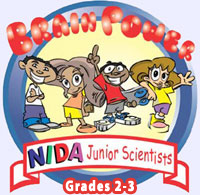
|

Medicines and Drugs: What’s Helpful, What’s Harmful (Module 4)
Additional Activities
Below are some additional activities that can be used after completion of the fourth mission. These activities are extensions to many other areas of the curriculum.
1. As a class, go to the Library/Media Center and look for books or Web sites about one or more of the drugs studied during the module. Take the books back to the class and read them together. Discuss what they mean and how they apply to what the students learned during the module.
2. Bring out the list the class generated during module 2, describing what the students wanted to learn about the brain. How much have they learned? What haven’t they learned? What additional things have they learned that are not included on the list? Do students have anything they would like to add to the list?
3. Play a "game show" using questions about drugs and how they are used. Students can take turns being the player, and the rest of the class can be the audience. If the player doesn't know the answer, he or she has the option of asking the audience for help. Make sure that everyone has a chance to be the player. Some sample questions are listed below...
Which drug can help prevent cavities?
|
- a. Tylenol
|
b. Aspirin |
- c. Fluoride
|
d. Antibiotics |
Which drug would a person take if he or she had an ear infection?
|
- a. Immunizations
|
b. Fluoride |
- c. Marijuana
|
d. Antibiotics |
In what common product is nicotine found? |
- a. Cigarettes
|
b. Beer |
- c. Coffee
|
d. Candy |
Why do people take caffeine? |
- a. To help them feel tired
|
b. To help them feel peppy |
- c. To help them feel angry
|
d. To help them feel sad |
What do people take for a fever? |
- a. Caffeine
|
b. Tylenol |
- c. Fluoride
|
d. Immunizations |
4. Have the students write a class story about the substances they learned about during this module. Begin with the prompt, "If I was stranded on a desert island, I would like to have _____________ with me."
5. Have students think back to what they learned about the parts of the brain in module 2 and neurotransmission in module 3. Have them make up riddles describing the parts of the brain or the process of neurotransmission. Have students see if they can guess the answer to each riddle.
|
Module 4 Contents
|
Module 4 Documents
|
|

|

|

|
Ordering Information
This package can be ordered by calling
1-877-NIDA-NIH and request "BPPACK"
Or it can be ordered online at backtoschool.drugabuse.gov.
|
|
Contact Information
For questions regarding NIDA's Science Education Program and Materials, contact
Cathrine Sasek, Ph.D., e-mail: csasek@nih.gov.
|
|